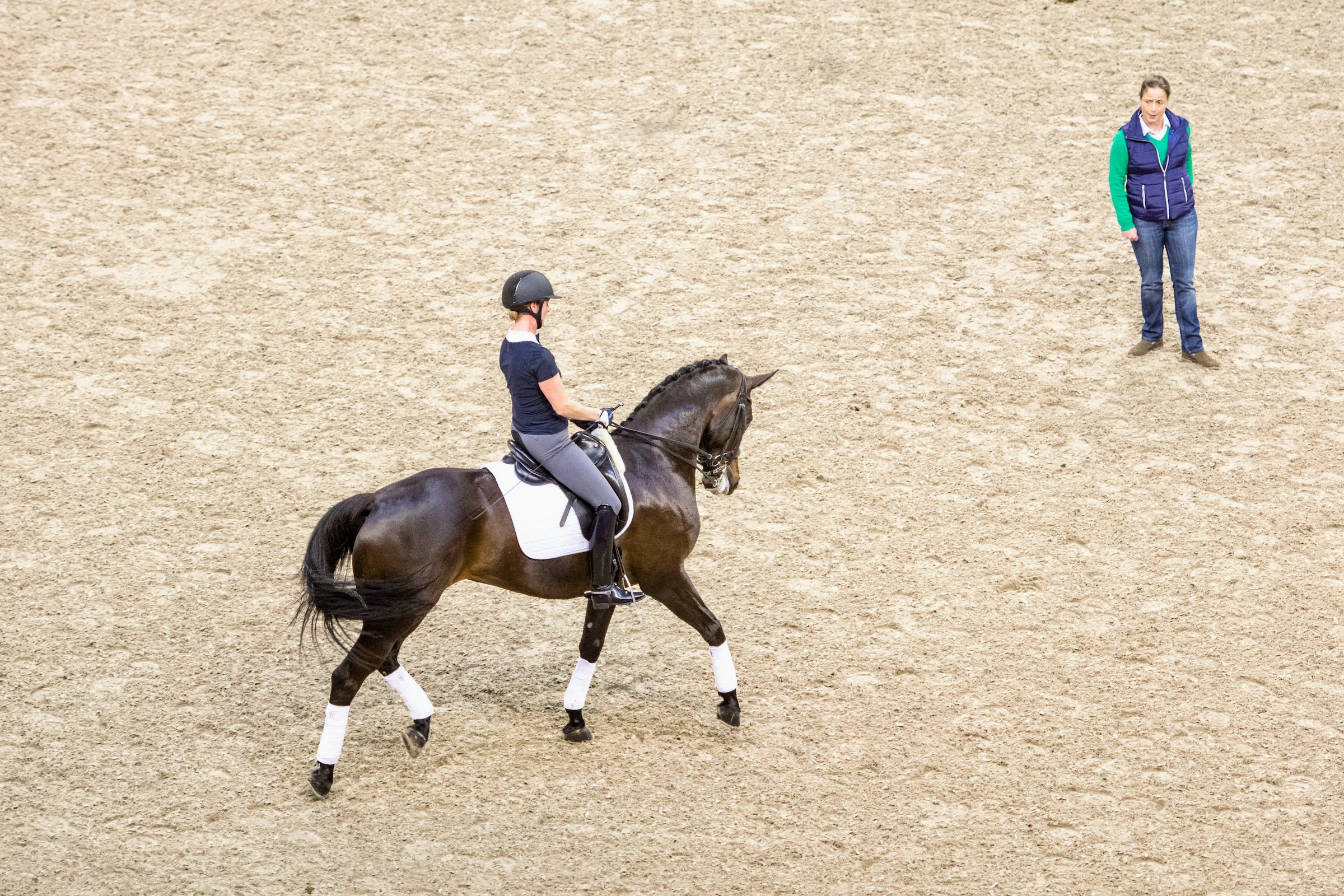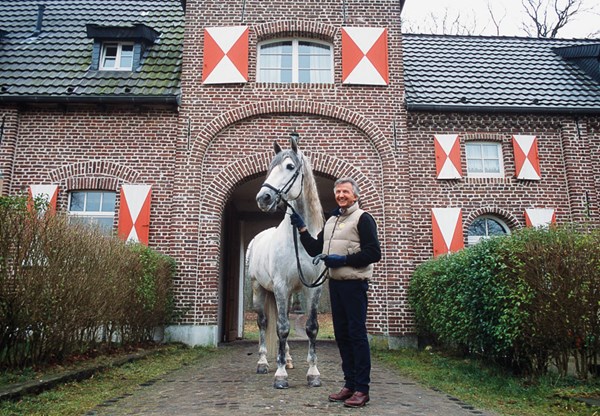This is the second installment of a four-part series discussing dressage clinics in the U.S. The first part addressed the auditor and now we turn to the rider. In the next two articles we’ll be discussing the clinician and the organizer/host. We hope you enjoy these articles and look forward to reading your comments.
Click here to read Part 1 on auditing the dressage clinic.
Imagine what it would be like to ride your horse with perfect poise, balance and harmony in every setting you brought him to, be it across the road or around the world; and regardless of who was watching—be it your family and friends, the Queen of England or a thousand of the world’s most dreadful critics. Be honest. Don’t we all dream of something like this? Whether you’re new to dressage, highly advanced or muddling through the long middle (where most riders find themselves), this article will clarify the purpose and mechanics of a dressage clinic. Riding in a dressage clinic is an important step toward competent riding in any setting.

As an Amazon Associate, Dressage Today may earn an affiliate commission when you buy through links on our site. Products links are selected by Dressage Today editors.
When it comes to passing on the passions and principles of classical dressage, clinics are a popular and powerful tool. The clinic provides opportunities to learn from top instructors from all over the world, and is an especially important resource for those riders without regular access to quality instruction.
Riders seek clinicians with a proven track record, who have succeeded in riding at a level above the rider’s current level and who are respected for their teaching style. Riders who are hungry for top-level training are willing to travel hundreds of miles and pay hundreds of dollars to ride with masters near and far like Debbie McDonald, Robert Dover, Carl Hester, Arthur Kottas and Charles de Kunffy, to name just a few.
While a clinician may be capable of teaching Training Level to Grand Prix, they may have a penchant for teaching at a specific level, so it pays to do a bit of research in advance. Adrienne Lyle, Grand Prix rider and a clinician herself, suggests watching the clinician teach (either in person or online) before riding with them. “It can give you a chance to absorb a lot of information and learn what they are looking for before the added pressure of being the one in the saddle. Not everyone who is a good rider is necessarily the right match to be your instructor. Watch a little first, so you’re sure you’re putting yourself in a situation that will be a positive learning experience for you and your horse.”
While some riders prefer clinicians with a style similar to their own, others are willing to branch out provided the basic principals, including respect and fairness to horse and rider, are in play.
If the idea of riding with a certain clinician causes anxiety, don’t let that stop you—it could be a good thing. Martin Arnold, USDF gold medalist says, “Clinicians are there to challenge you so you’ll probably be asked to do things outside of your comfort zone that won’t feel successful, but that’s all part of the growth process.”
Although riders are willing to travel great distances to ride with respected clinicians, they are often reined in by time and budget constraints. The price per ride varies with the clinician and venue. A typical ride consists of 45-60 minutes of individual time with the clinician and costs from $100-300, although $600 rides are not unheard of. Consider also that a typical clinic lasts two to three days, with most riders taking one or more riding spots per day. Because the first day is often spent with the instructor getting to know the horse and rider, and the horse settling in to the new environment, there is added benefit to riding two or three days in a row. But add to this the cost of fuel, stabling, hotel and meals and you’re rapidly approaching $1,000 for a clinic weekend. For this reason, many riders purchase just one ride spot. The experience and information and camaraderie you gain from even one ride will usually be worth your while.
“Perhaps one of the least expected and most rewarding consequences of clinic participation revolves around the camaraderie among participants. I am surrounded and supported by some of the most incredible, inspiring and well-respected riders in this country—and sometimes beyond. We share in each other’s growth, successes and headaches. It’s so important to have moral support from fellow ambassadors of the sport. It can be a difficult journey. And a rewarding one. But no one succeeds alone. As they say, it takes a (very large) village!” —Abby Onsgard, USDF Silver Medalist and USDF L Program Participant
But how to prepare? Some riders approach a clinic with the same focus they use for a show, while others are more relaxed. It depends on what the rider hopes to gain from the clinic experience. Some are there to be noticed or get recognition for their horse, in which case it can be full-on show-time preparation, with groomers and body workers to boot. It’s a reality of the dressage world that sometimes at a clinic—especially one taught by a world-renowned clinician—a rider may gain a sponsor, new clients, or a leg up in her career in some other way.

But most riders are there to further their knowledge and experience, to improve their riding and expand their and their horse’s comfort zone. While still wanting to do their best and make a good impression, the preparation can be as simple as staying with the regular warm-up routine, washing the horse, polishing the tack and packing well. JJ Tate, FEI rider and clinician says, “I make sure we are both fit and sound. I also make sure that if we’ve traveled, my horse is comfortable in the new surroundings so that the lesson isn’t wasted on getting him to relax.”
Seasoned riders know it takes a lot to run a clinic. They’re especially appreciative of a well-maintained arena, good sound system and hosts who are available, make introductions and keep the clinic on schedule. It makes things easier, too, if lunch is provided and water is available. A lecture during lunch and dinner with the clinician help riders connect with one another and the clinician, which tends to further the learning and lighten the atmosphere. When you get a group of like-minded people together seeking what’s best for the horse, a sense of community rapidly gels and a bit of fun is inevitable.
“The first time I rode with Walter Zettl, on my four-year old, I was trotting around the arena during my warm up when suddenly both reins came off the bit! My husband had cleaned my bridle for me but didn’t buckle the reins to the snaffle bit. Fortunately, he was a very good horse and stopped without the reins, but several people came running into the arena, fearing I was in a lot of trouble! Walter said that while we should not need reins to stop, it would probably be a good idea to buckle the reins properly before we continued the lesson.” —Heidi Wright, FEI rider
Finally, keep an open mind. Accept that in a clinic you will be asked to do things you don’t normally do, and that you may not feel successful because new things often leave us feeling awkward and unsure instead of inspired. Take time to truly hear what the clinician is saying. It may not make perfect sense right away but in a few days, weeks or even months the lesson may finally click and you’ll be closer than ever to realizing your riding dream.
Rider’s Checklist for Clinics
•Registration (and waivers)
•Stabling for your horse
•Hotel or other accommodations for you
•Check book
•Coggins, vaccination record and health certificate as required
•Saddle
•Muck bucket, fork, shavings
•Hay, grain, supplements, treats
•Cooler/blanket
•Clothes, including extra breeches
•Food, snacks, water
How to Find Clinics Near You
Check with your local dressage association/club, trainer and friends. Google your favorite trainers and check their schedules which are often published on their website or social media pages. Get on their email lists and follow them on social media. Visit with other riders and local dressage barns. Other sources include the USDF.com and StriderPro.com.











